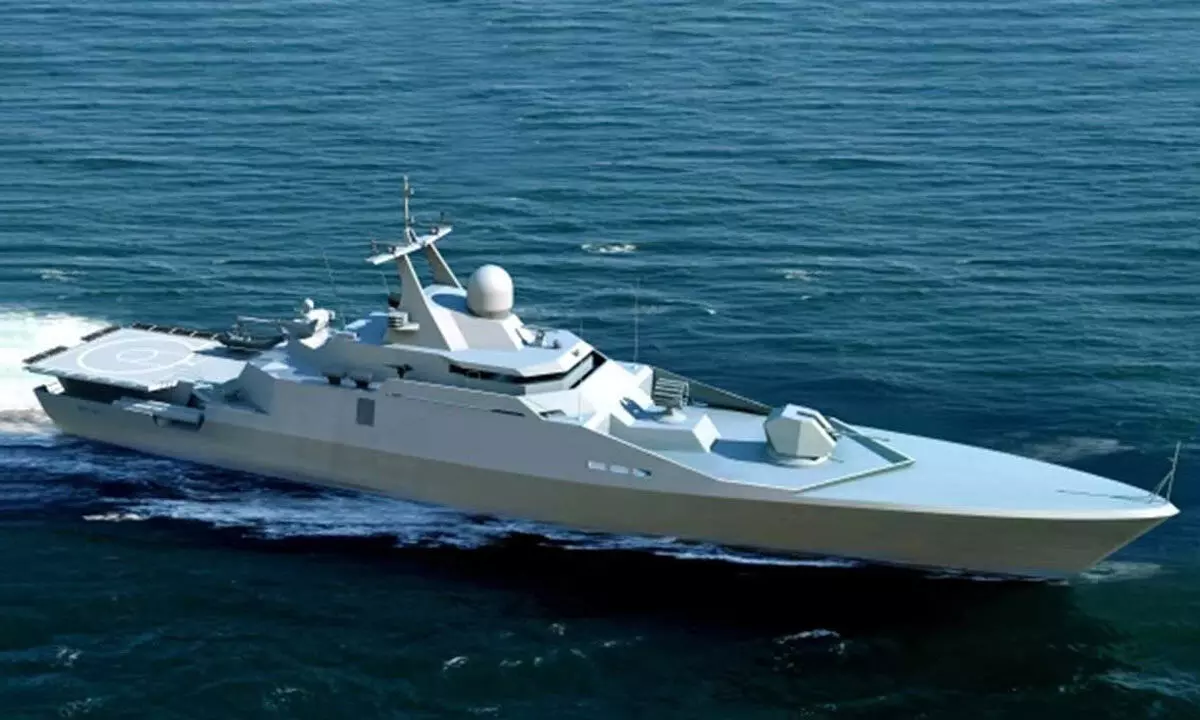Live
- BGT: 'Rohit is short of confidence with self-doubts', opines Manjrekar
- Gold gains 30 pc in 2024, silver 35 pc up on COMEX this year: MOFSL
- Delhi HC dismisses anticipatory bail plea of ex-IAS trainee officer Puja Khedkar
- Untouched Goa Beaches You Must Visit in January
- Muzigal launches its State-of-the-art Music Academy in Nallagandla, Hyderabad
- Thoughtful Christmas Gifts for Every Loved One
- South Korea: Finance minister silent on martial law probe amid speculation on acting president's role
- Karnataka Minister Laxmi Hebbalkar Vows To Pursue Justice Against CT Ravi
- Stands By Vijayaraghavan Amid Row Over Remarks On Gandhis
- Karnataka Legislative Council Chairman Denies Recording Controversial Exchange
Just In
New Age Anti-Submarine Water Crafts Launched


Representational image
INS Malpe and INS Mulki Join Fleet
Udupi: In a stride towards bolstering India's naval defence, two advanced Anti-Submarine Warfare Shallow Water Crafts(ASW-SWC), INS Malpe and INS Mulki, were recently launched at Cochin Shipyard Limited (CSL), Kerala. These ships, the fourth and fifth in the series, are part of the Indian Navy's project to construct a total of eight ASW-SWC under the Mahe class, marking an important chapter in the country's self-reliance efforts in defence production.
INS Malpe and INS Mulki carry historical significance, paying homage to Karnataka's coastal towns of Malpe in Udupi and Mulki in Dakshina Kannada districts. These ships were previously associated with Russian-imported mine-sweeping vessels that served the Indian Navy between the 1980s and early 2000s.
The original INS Mulki, commissioned on May 10, 1984 and decommissioned in 2003, was part of a fleet of six vessels dedicated to detecting and clearing mines along the Indian coastline. INS Malpe, also commissioned on the same day in 1984, operated similarly until it was decommissioned in 2006.
While the earlier versions of these ships played vital roles in securing maritime routes from underwater mines, the new vessels bring cutting-edge technology and enhanced capabilities to the Indian Navy.
The latest variants of INS Malpe and INS Mulki represent the new Mahe class of ASW-SWCs, designed indigenously to meet modern defence needs. Constructed entirely in India by CSL, these vessels boast state-of-the-art technology, including SONAR systems capable of underwater surveillance and the detection of enemy submarines in coastal waters.
According to reports, each of these new vessels is 78 meters long, 11.36 meters wide, and has a draught of 2.7 meters, displacing around 900 tonnes. They are capable of reaching speeds of up to 25 knots and can cover a range of 1,800 nautical miles, making them ideal for a variety of naval operations.
The ships are equipped with light-weight torpedoes, anti-submarine warfare rockets, remote-controlled guns, and a close-in weapon system for self-defence. Their versatile design allows them to conduct not only anti-submarine warfare but also mine-laying, coastal surveillance, as well as search and rescue missions.
One of the most striking aspects of the INS Malpe and INS Mulki project is its contribution to India's 'Aatmanirbhar Bharat' (self-reliant India) mission. Reports suggest that more than 80% of the components used in constructing these ships are sourced from Indian manufacturers. This focus on indigenous production is expected to enhance the country's defence manufacturing capabilities while generating local employment.
The advanced technology and operational flexibility of these vessels make them indispensable for the Indian Navy’s coastal and shallow water operations. They are built to detect and neutralise enemy submarines and underwater mines near India's extensive coastline, especially around strategically important areas like island territories. The inclusion of modern underwater sensors enhances the ships’ abilities to operate in low-intensity maritime environments.
Like their predecessors, the new INS Malpe and INS Mulki are expected to play crucial roles in safeguarding India's maritime interests. Their launch serves as a reminder of the country's rich naval history, particularly the importance of Karnataka's coastal towns, which were once bustling ports facilitating trade between India and foreign countries. The coastal towns of Mulki and Malpe are even marked on British-era sea charts, attesting to their maritime significance.
As India continues to modernise its naval forces, these anti-submarine warfare vessels will be key in securing the nation’s coastal waters, maintaining peace, and responding to new maritime threats. With indigenous technology at their core, INS Malpe and INS Mulki embody both India's naval prowess and its determination to achieve self-sufficiency in defence production. (eom)

© 2024 Hyderabad Media House Limited/The Hans India. All rights reserved. Powered by hocalwire.com






